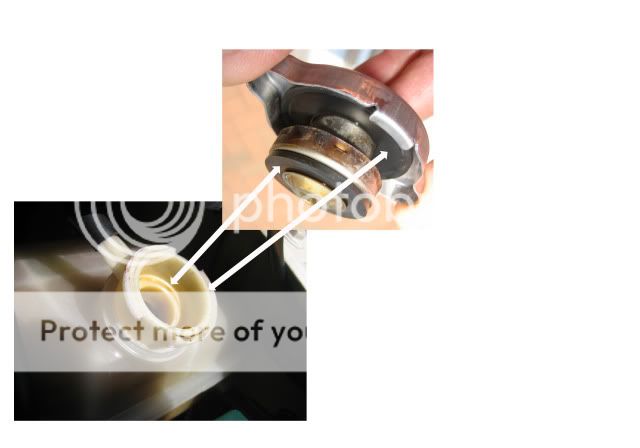Are you really sure this cap has a vaccum valve? and if so, where might I find it?
More to the point, is my cap the correct one
edit - pic of the cap

Moderators: Doone, westonwarrior

Spot on......Ron Miel wrote: Simplification helps get first principles over but doesn't this only take account of two of the dynamic processes involved?
As well as any gradual coolant leaking causing this build up of air in the head and its pressurisation by combustion heat, progressive entraining of that air into coolant flowing by it will also gradually carry it off to the expansion tank, where the tank's inbuilt coolant vortexing/de-gassing compartments will separate it out from the coolant - causing an equal air build up and drop in coolant level in the ex tank but away from combustion processes.
In other words, although the topmost inner part of the head is a sealed high point where air will initially tend to collect, that doesn't mean that's then a static condition. That's what the second high revving stage (ex tank pressure cap re-fitted/system sealed) of the bleeding process is about. It works by entraining any small amounts of still trapped air anywhere in the system (including heaters, although probably less effectively due to the lesser air/coolant interface there) into coolant flow, to be carried away for de-gassing. Note that if there's still enough air trapped anywhere to cause a complete blockage, no amount of water pump pressure will clear it, so there will be no coolant flow and the de-gas process will not work. Hence the importance of carrying out earlier refill stages (cold fill, and bleed tube venting) very carefully first.
That overall de-gas process will only remove head-trapped air up to its system designed rate though, so in a more leaky engine a point will arrive where air collects in the head roof too fast to be carried away before causing progressive head overheating/weakening. Hence the need to keep all coolant connections as airtight as possible, to deal with even the smallest of detected leaks immediately (or stop driving), and to replace spongy hoses (they don't have to burst to slowly leak), etc. It also means that observed slow reductions of coolant level at the expansion tank should never be allowed to continue, and the cause(s) must quickly be found and rectified.
Maybe it has, maybe it hasn't - however it doesn't work like the one in your link to 'how stuff works'.Are you really sure this cap has a vaccum valve?
dave_aber wrote:Maybe it has, maybe it hasn't - however it doesn't work like the one in your link to 'how stuff works'.Are you really sure this cap has a vaccum valve?
My son's Toyota Starlet has the same arrangement as that animation, a pressurised radiator with a (in his case) 0.9 Barg cap which vents when over-pressurised into an overflow bottle. The vent pipe is always submerged in the coolant in this bottle, so when the cooling system 'sucks' back under cooling/contraction, it doesn't draw in air. (Presumably, any air in the system will collect under the cap, and be expelled into the bottle never to return?)
In our case, the expansion tank always has air in the top, up under the cap. Under overpressure situations, the cap lifts and the excess air pressure is let out. Whatever pressure builds up in the system, it won't exceed 1.1 Barg as the cap would let it out. When the system cools, the air in the header is at 1.1 Barg initially. As the coolant contracts, the air expands and lowers back to 0 Barg.
I'm sure a simple rig could be built to test if the cap will pass air when in a reverse pressure situation. This could also be tested by getting the coolant warm enough to raise the level in the tank, with the cap off, and then refitting it. Let the engine completely cool down, and remove the cap. If a partial vacuum can be heard equalising then the cap doesn't have a vac valve. If it doesn't suck air in, the it must have been doing it gradually through the cap....
we are all starting to agree with each other.
With grateful acknowledgment to the stuff you sent me on de-gassing particularly Mike. Might be worth providing a link to the very interesting Toyota patent on the subject, for anybody retired/with time on their hands, like Steve and I, and/or for pure Bongomasochists for that mattermikexgough wrote:
Spot on......
Actually, in principle, I think it does Dave. The one in the link is for a conventional cooling system and as such is fitted to the main radiator (thought I mentioned that????........dave_aber wrote:Maybe it has, maybe it hasn't - however it doesn't work like the one in your link to 'how stuff works'.Are you really sure this cap has a vaccum valve?
dave_aber wrote:we are all starting to agree with each other.
(Next we'll be agreeing with Bongo Forum!)
Hate to say this, but I have to agreeActually, in principle, I think it does Dave
Thank the Lord for that - couldn't cope if you disagreed - would mean I'd got it wrongdave_aber wrote:......, but I have to agreeActually, in principle, I think it does Dave.
Oh yes..... now that is a great car.....and the engine is just superb.... Got plenty of parts stilldave_aber wrote:Contrast the Bongo with the humble 2CV. The engine has 24 seperate moving parts - and one of them is the oil.
Got in one!widdowson2008 wrote: